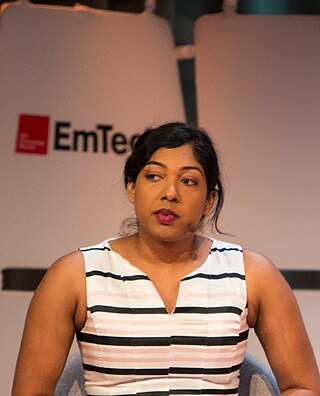Related Research Articles
In artificial intelligence, an expert system is a computer system emulating the decision-making ability of a human expert. Expert systems are designed to solve complex problems by reasoning through bodies of knowledge, represented mainly as if–then rules rather than through conventional procedural code. The first expert systems were created in the 1970s and then proliferated in the 1980s. Expert systems were among the first truly successful forms of artificial intelligence (AI) software. An expert system is divided into two subsystems: the inference engine and the knowledge base. The knowledge base represents facts and rules. The inference engine applies the rules to the known facts to deduce new facts. Inference engines can also include explanation and debugging abilities.
Internal medicine, also known as general internal medicine in Commonwealth nations, is a medical specialty for medical doctors focused on the prevention, diagnosis, and treatment of internal diseases. Medical practitioners of internal medicine are referred to as internists, or physicians in Commonwealth nations. Internists possess specialized skills in managing patients with undifferentiated or multi-system disease processes. They provide care to both hospitalized (inpatient) and ambulatory (outpatient) patients and often contribute significantly to teaching and research. Internists are qualified physicians who have undergone postgraduate training in internal medicine, and should not be confused with "interns”, a term commonly used for a medical doctor who has obtained a medical degree but does not yet have a license to practice medicine unsupervised.
Knowledge engineering (KE) refers to all technical, scientific and social aspects involved in building, maintaining and using knowledge-based systems.
MYCIN was an early backward chaining expert system that used artificial intelligence to identify bacteria causing severe infections, such as bacteremia and meningitis, and to recommend antibiotics, with the dosage adjusted for patient's body weight — the name derived from the antibiotics themselves, as many antibiotics have the suffix "-mycin". The Mycin system was also used for the diagnosis of blood clotting diseases. MYCIN was developed over five or six years in the early 1970s at Stanford University. It was written in Lisp as the doctoral dissertation of Edward Shortliffe under the direction of Bruce G. Buchanan, Stanley N. Cohen and others.
A clinical decision support system (CDSS) is a health information technology that provides clinicians, staff, patients, and other individuals with knowledge and person-specific information to help health and health care. CDSS encompasses a variety of tools to enhance decision-making in the clinical workflow. These tools include computerized alerts and reminders to care providers and patients, clinical guidelines, condition-specific order sets, focused patient data reports and summaries, documentation templates, diagnostic support, and contextually relevant reference information, among other tools. CDSSs constitute a major topic in artificial intelligence in medicine.
INTERNIST-I was a broad-based computer-assisted diagnostic tool developed in the early 1970s at the University of Pittsburgh as an educational experiment. The system was designed to capture the expertise of just one man, Jack D. Myers, MD, chairman of internal medicine in the University of Pittsburgh School of Medicine. The Division of Research Resources and the National Library of Medicine funded INTERNIST-I. Other major collaborators on the project included Randolph A. Miller and Harry E. Pople.
Self-diagnosis is the process of diagnosing, or identifying, medical conditions in oneself. It may be assisted by medical dictionaries, books, resources on the Internet, past personal experiences, or recognizing symptoms or medical signs of a condition that a family member previously had.

Alan L. Rector is a Professor of Medical Informatics in the Department of Computer Science at the University of Manchester in the UK.

Computer-aided detection (CADe), also called computer-aided diagnosis (CADx), are systems that assist doctors in the interpretation of medical images. Imaging techniques in X-ray, MRI, Endoscopy, and ultrasound diagnostics yield a great deal of information that the radiologist or other medical professional has to analyze and evaluate comprehensively in a short time. CAD systems process digital images or videos for typical appearances and to highlight conspicuous sections, such as possible diseases, in order to offer input to support a decision taken by the professional.

Frank van Harmelen is a Dutch computer scientist and professor in Knowledge Representation & Reasoning in the AI department at the Vrije Universiteit Amsterdam. He was scientific director of the LarKC project (2008-2011), "aiming to develop the Large Knowledge Collider, a platform for very large scale semantic web reasoning."
Edward ("Ted") Hance Shortliffe is a Canadian-born American biomedical informatician, physician, and computer scientist. Shortliffe is a pioneer in the use of artificial intelligence in medicine. He was the principal developer of the clinical expert system MYCIN, one of the first rule-based artificial intelligence expert systems, which obtained clinical data interactively from a physician user and was used to diagnose and recommend treatment for severe infections. While never used in practice, its performance was shown to be comparable to and sometimes more accurate than that of Stanford infectious disease faculty. This spurred the development of a wide range of activity in the development of rule-based expert systems, knowledge representation, belief nets and other areas, and its design greatly influenced the subsequent development of computing in medicine.

Medical diagnosis is the process of determining which disease or condition explains a person's symptoms and signs. It is most often referred to as diagnosis with the medical context being implicit. The information required for diagnosis is typically collected from a history and physical examination of the person seeking medical care. Often, one or more diagnostic procedures, such as medical tests, are also done during the process. Sometimes the posthumous diagnosis is considered a kind of medical diagnosis.
Functional disorder is an umbrella term for a group of recognisable medical conditions which are due to changes to the functioning of the systems of the body rather than due to a disease affecting the structure of the body.
The history of medical diagnosis began in earnest from the days of Imhotep in ancient Egypt and Hippocrates in ancient Greece but is far from perfect despite the enormous bounty of information made available by medical research including the sequencing of the human genome. The practice of diagnosis continues to be dominated by theories set down in the early 20th century.
Chronic Lyme disease (CLD) is the name used by some people with "a broad array of illnesses or symptom complexes for which there is no reproducible or convincing scientific evidence of any relationship to Borrelia burgdorferi infection" to describe their condition and their beliefs about its cause. Both the label and the belief that these people's symptoms are caused by this particular infection are generally rejected by medical professionals. Some doctors view the promotion of chronic Lyme disease as an example of health fraud. Chronic Lyme disease is distinct from genuine Lyme disease, a known medical disorder caused by infection with Borrelia burgdorferi, or with post-treatment Lyme disease syndrome, a set of lingering symptoms which may persist after successful treatment of infection with Lyme bacteria.

Artificial intelligence in healthcare is an overarching term used to describe the use of machine-learning algorithms and software, or artificial intelligence (AI), to mimic human cognition in the analysis, presentation, and comprehension of complex medical and health care data, or to exceed human capabilities by providing new ways to diagnose, treat, or prevent disease. Specifically, AI is the ability of computer algorithms to approximate conclusions based solely on input data.

Explainable AI (XAI), also known as Interpretable AI, or Explainable Machine Learning (XML), either refers to an AI system over which it is possible for humans to retain intellectual oversight, or to the methods to achieve this. The main focus is usually on the reasoning behind the decisions or predictions made by the AI which are made more understandable and transparent. XAI counters the "black box" tendency of machine learning, where even the AI's designers cannot explain why it arrived at a specific decision.

Shinjini Kundu is an Indian American physician and computer scientist at The Johns Hopkins Hospital in Baltimore, Maryland. Her research focuses on designing artificial intelligence systems to detect diseases that may be imperceptible to humans. She was named one of Forbes 30 under 30, MIT Technology Review's 35 innovators under 35, a World Economic Forum Young Global Leader, and a winner of the Carnegie Science Award.

Merative L.P., formerly IBM Watson Health, is an American medical technology company that provides products and services that help clients facilitate medical research, clinical research, real world evidence, and healthcare services, through the use of artificial intelligence, data analytics, cloud computing, and other advanced information technology. Merative is owned by Francisco Partners, an American private equity firm headquartered in San Francisco, California. In 2022, IBM divested and spun-off their Watson Health division into Merative. As of 2023, it remains a standalone company.
References
- 1 2 Wolfram, D. A. (1 April 1995). "An appraisal of INTERNIST-I". Artificial Intelligence in Medicine. 7 (2): 93–116. doi:10.1016/0933-3657(94)00028-Q.
- ↑ The Fifth Generation. Edward A. Feigenbaum and Pamela McCorduck. Addison-Wesley, Reading, Ma 01867, 275 Pp. Feb 1, 1984
- 1 2 3 Batson, Eric (February 1984). "Computer as consultant: Application of artificial intelligence in diagnosis". Postgraduate Medicine. 75 (2): 211–214. doi:10.1080/00325481.1984.11697944.